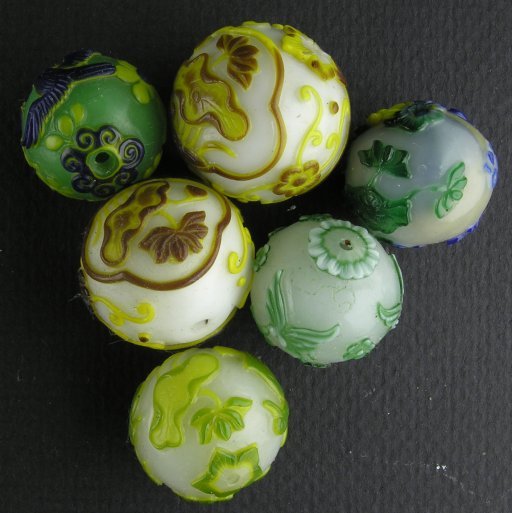When given the opportunity, I chose a bunch of these beautifully detailed carved Chinese beads. How do I know they're Chinese? Well, I don't, except that the guy who gave ’em to me said so; and the iconography is certainly chinese. So they're probably made with kinari, a soft leaded glass reported to be similiar to the Japanese satake. Certainly the beads have that translucent look of ‘greasy’ glass that is typical of some satake colors, the Effetre alabastro/opalino series, and what I remember from a brief inspection of someone else's kinari sample set (many years ago) kinari to look like.
There are a couple of things to note with these beads. Obviously they're cased, and the artisans doing the carving (likely different from the ones who actually made the beads) cut through the outer, colored layers of yellow, brown, green or blue glass to the interior hues of white, or, in one example, green base glass. I found the holes to be particularly beautifully finished, as with the cloud motif on the upper left (green) bead with the phoenix and the lotuses on the two middle beads (top and bottom).
The green and white bead to the right, in addition to its lovely pleated motif finishing the hole, is interesting for another reason: if you inspect the bead closely (click on the 512 pixel image for a larger one) you can just barely make out a cloud motif that appears to have been removed. Evidently someone decided to remove this part of the design—maybe because it chipped; maybe because they decided the hole decoration would be more effective bracketed by white space to show it off. In any event, happy accident or decision to change the design (or some combination of both, which is closer to what happens in the real world—that's ye ole ‘working with your medium, not fighting it’ thing) the result is a better looking bead.
As much as I admire flawlessly executed pieces, the mistakes and problems are often quite fascinating signposts to construction technique.
file originally created 08oct06
Unless otherwise noted, text, image and objects depicted therein copyright 1996--present sylvus tarn.
Sylvus Tarn